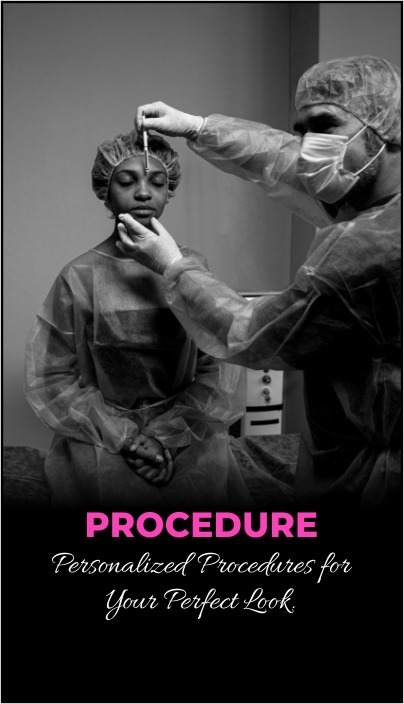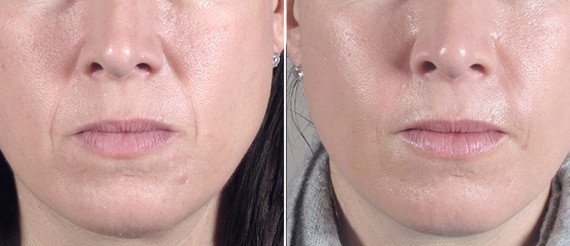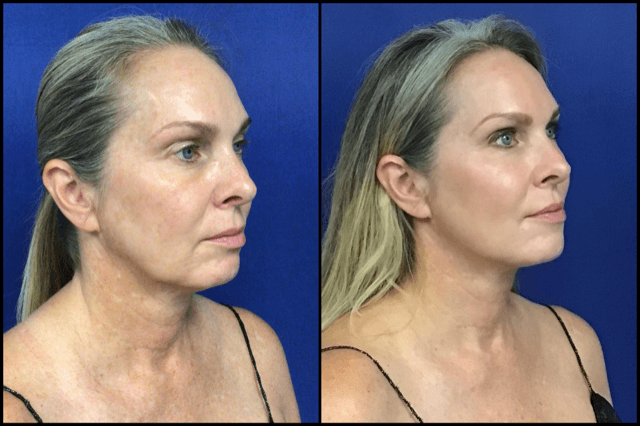

A facial fat transfer, also known as an autologous fat transfer, is a cosmetic procedure in which a person’s own body fat is used to restore volume to and plump up sunken or sagging areas of the face.
Because the patient’s own fatty tissue is used, the process involves three steps: liposuction to remove fat, purifying the fat cells, and injecting them into the desired areas of the face.
This procedure can treat smile and frown lines, marionette lines, wrinkles, hollowed areas under the eyes or cheekbones, and scars or depressions on the face caused by acne.


Ideal candidates for a facial fat transfer are individuals looking to reduce signs of aging such as furrows, wrinkles, and sunken areas. Younger patients may also be eligible for lip augmentation or volume restoration in other facial areas.
This treatment is also ideal for those suffering from lipoatrophy, which refers to the loss of fat in the cheeks and jawline, making the face look gaunt.
Facial fat transfer can target various areas of the face, including deep creases on the forehead, hollow areas under the cheeks and eyes, and contours around the nose, temples, upper lip, and jawline.
This procedure can reduce the appearance of scars, sunken or sagging skin, and plump areas that have lost their original volume.
Some areas may require a single treatment to produce visible results, while others might need more than one fat injection to reach the desired contour.
Because the patient’s own fat is used, there is no risk of allergic reactions, making it a safe option for most. During the consultation, you will be asked about your medical history, existing medical conditions, medications, and lifestyle habits like smoking or the use of blood-thinners.
Your cosmetic surgeon will use this information to determine if you are a suitable candidate for a facial fat transfer.
If your facial issue isn't mentioned here, you should still consult a dermatologist or cosmetic surgeon. They may recommend a facial fat transfer or combine it with other treatments such as Botox, Radiesse, or CosmoPlast to address your concerns.
Unlike dermal fillers, a facial fat transfer does not introduce any foreign substances into the body. This makes fat injections ideal for patients with allergies or sensitivities to substances like collagen or Hylaform.
Another major distinction is the longevity of the results. A facial fat transfer can last from several months to two years, with some results even being permanent. On the other hand, dermal fillers (especially those with hyaluronic acid) typically require repeat treatments as the results fade within a few months.
If you’re in the Orange County area, scheduling a consultation will allow you to discuss your options, including whether facial fat grafting is the right choice for you. A personalized meeting will focus on your aesthetic goals, and any concerns you have.
During the consultation, you'll be asked about your medical history, smoking habits, and medications. Before & After photos of past patients will also be shown, and cost and payment options will be reviewed before scheduling your procedure.
Facial fat injections can be performed alone or alongside other procedures such as a face or neck lift. Swelling and bruising generally last 1-3 weeks, depending on the amount of fat injected. A compressive garment may be worn over the liposuctioned areas for optimal healing.
The procedure consists of three steps: fat removal via liposuction, purifying the fat cells, and injecting them into the targeted areas on the face. Results are noticeable immediately and can last for months, years, or even permanently in some cases.
A facial fat transfer is an outpatient procedure. You’ll be discharged the same day and start recovery at home. Avoid blood thinning medications like aspirin and ibuprofen two weeks before the procedure. Since your own fat cells are used, there’s no need for allergy testing.
The first step of a facial fat transfer involves liposuction from donor sites such as the jowls, buttocks, abdomen, thighs, hips, or “saddlebags.” A low-impact liposuction technique is used to collect mostly undamaged fat cells.
After collecting the fat cells, they are placed in a centrifuge that separates healthy fat from any liquid drawn out during liposuction. Only purified fat is used for the injection process.
The final step is to inject the purified fat into the desired areas of the face. Strategic injection sites are chosen to restore volume, eliminate imperfections, or enhance contour.
Unlike dermal fillers, a facial fat transfer does not introduce any foreign substances into the body. This makes fat injections ideal for patients with allergies or sensitivities to substances like collagen or Hylaform.
Another major distinction is the longevity of the results. A facial fat transfer can last from several months to two years, with some results even being permanent. On the other hand, dermal fillers (especially those with hyaluronic acid) typically require repeat treatments as the results fade within a few months.
If you’re in the Orange County area, scheduling a consultation will allow you to discuss your options, including whether facial fat grafting is the right choice for you. A personalized meeting will focus on your aesthetic goals, and any concerns you have.
During the consultation, you'll be asked about your medical history, smoking habits, and medications. Before & After photos of past patients will also be shown, and cost and payment options will be reviewed before scheduling your procedure.
Facial fat injections can be performed alone or alongside other procedures such as a face or neck lift. Swelling and bruising generally last 1-3 weeks, depending on the amount of fat injected. A compressive garment may be worn over the liposuctioned areas for optimal healing.
The procedure consists of three steps: fat removal via liposuction, purifying the fat cells, and injecting them into the targeted areas on the face. Results are noticeable immediately and can last for months, years, or even permanently in some cases.
A facial fat transfer is an outpatient procedure. You’ll be discharged the same day and start recovery at home. Avoid blood thinning medications like aspirin and ibuprofen two weeks before the procedure. Since your own fat cells are used, there’s no need for allergy testing.
The first step of a facial fat transfer involves liposuction from donor sites such as the jowls, buttocks, abdomen, thighs, hips, or “saddlebags.” A low-impact liposuction technique is used to collect mostly undamaged fat cells.
After collecting the fat cells, they are placed in a centrifuge that separates healthy fat from any liquid drawn out during liposuction. Only purified fat is used for the injection process.
The final step is to inject the purified fat into the desired areas of the face. Strategic injection sites are chosen to restore volume, eliminate imperfections, or enhance contour.
After your facial fat transfer procedure, it’s normal to experience some slight swelling and bruising at the donor or injection sites. Swelling typically lasts just a few days, and any pain can be managed with medication. It's essential to follow the postoperative instructions provided by your surgeon.
Most patients are able to resume their normal daily activities within 48 hours of the procedure. Once the swelling subsides, you’ll notice a more youthful appearance almost immediately. The results are long-lasting, often outlasting dermal fillers, with effects ranging from several months to years, or even permanently.
Once the initial swelling decreases, the full results of the facial fat transfer will become more visible. Patients will experience restored volume and a rejuvenated appearance. While individual results vary, many patients enjoy long-lasting, natural-looking improvements that extend far beyond what dermal fillers can offer.
The duration of the results can last several months, years, or even be permanent depending on individual factors, making facial fat transfer a highly effective option for facial rejuvenation.
One of the greatest benefits of a facial fat transfer is that it is a natural and safe cosmetic procedure. Since the injected material is your own fat, there is no risk of an allergic reaction. Your body recognizes and accepts its own fat readily, making this a very safe and effective method for restoring volume and contouring the face.
Moreover, facial fat transfer is versatile, allowing for treatments like lip augmentation, scar reduction, and the correction of sunken areas. This also means that it pairs well with other cosmetic treatments such as Botox and chemical peels.
The long-lasting results are a major advantage. Compared to dermal fillers and other injectables, the results of a fat transfer can last years, sometimes even permanently. This procedure can also treat a variety of facial areas, including scars, sunken skin, or concave spots, enhancing overall facial harmony.
If you have any concerns or questions about the treatment, you can always reach out to our knowledgeable staff, or schedule an appointment with Dr. Sivakumar to discuss your options in detail.
